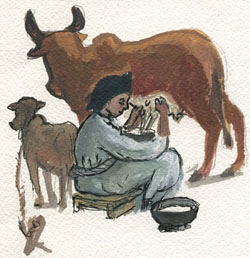12.4.3 Essentials of milk hygiene
Milk sanitation, i.e. the protection of milk from dirt and contamination, is essential to prevent milk infection. Clean milk (with a low number of bacteria) is a necessity, and is possible by using good milking hygiene (Figure 12.9).

The essential steps in hygienic milk production are summarised in Box 12.1.
Box 12.1 Hygienic milk production
- Animals must be clean and healthy.
- Milking should be done away from the herd.
- The milk handler should also be clean and healthy. S/he should wear clean outer garments during milking or processing the milk.
- The milking room should be clean, ventilated and dustless.
- Utensils and equipment for milking and milk handling must be clean.
- Immediately before milking the udder and teats of the cow must be washed with clean lukewarm water and dried with clean cloths – a separate one for each cow.
- Immediately after milking the milk must be removed from the shed, placed in a clean and covered receptacle and kept in a cool place.
12.4.2 Diseases that may be transmitted from milk cows
